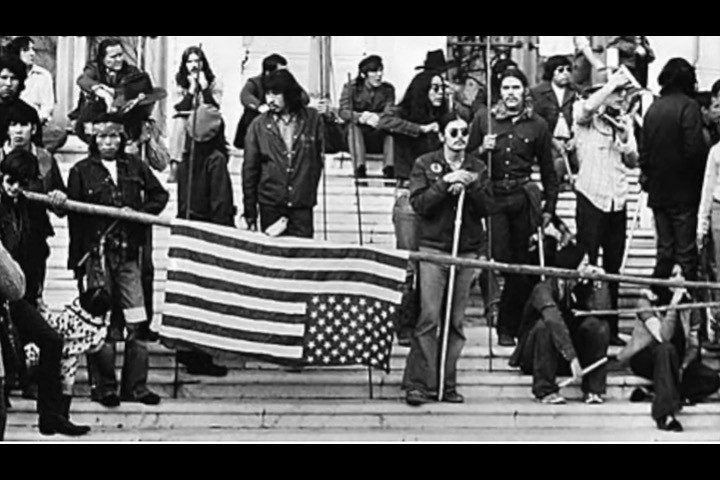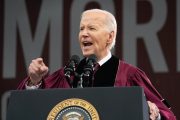
Fifty years ago, the militant political and civil rights group American Indian Movement (AIM) organized a cross-country caravan called the “Trail of Broken Treaties,” designed to bring national attention to Native American grievances by gathering in Washington, D.C., in protest. By the end of the week AIM leaders and caravan members had occupied the Bureau of Indian Affairs (BIA) office building in a siege which bore little resemblance to the Jan. 6 “riot” at the U.S. Capitol. It lasted much longer, six days vs. several hours. And the Native Americans didn’t storm inside but rather walked in and then refused to leave.
AIM was founded in 1968 by activist Dennis Banks and other Native American leaders. From November 1969 to June 1971, AIM members occupied Alcatraz Island off San Francisco, saying they had rights to it under a treaty provision granting them unused federal land, with their stated intention to use the island for an Indian school, cultural center, and museum. The Nixon administration opted to bide its time and leave the occupiers alone as long as they remained peaceful. The AIM protesters’ support waned, and they were forced to leave the island in defeat.
Then, on October 6, 1972, AIM rallied support for the “Trail of Broken Treaties” caravan. Three groups departed from Seattle, San Francisco, and Los Angeles, accompanied by Native American spiritual leaders. The caravans passed through several Indian reservations on the way to Washington, D.C., and at each stop AIM activists held drum circles and workshops to recruit participants and draft an agenda for Indian policy reform. The caravans arrived in Washington, D.C., on November 2, just before the 1972 presidential election, a perfect opportunity for anyone seeking media coverage.
Before arriving in D.C., caravan leaders convened in St. Paul, Minnesota, where they drafted a 20-point position paper titled The Trail of Broken Treaties. The manifesto demanded legal recognition of treaties, restoration of the treaty-making process, the return of 110 million acres of Native American land to indigenous communities, and the reform of federal-tribal relations. A fourth caravan departed from Oklahoma and symbolically retraced the path of the Trail of Tears.
Along with the position paper, AIM issued a press release stating their intent:
We seek a new American majority — a majority that is not content merely to confirm itself by superiority in numbers, but which by conscience is committed toward prevailing upon the public will in ceasing wrongs and in doing right. For our part, in words and deeds of coming days, we propose to produce a rational, reasoned manifesto for construction of an Indian future in America. If America has maintained faith with its original spirit, or may recognize it now, we should not be denied.
When the caravan departed St. Paul for D.C., the “Trail of Broken Treaties” caravan was over four miles long and included some 700 activists from more than 200 tribes and 25 states. Frances Wise of Oklahoma recalled, “A lot of people joined us. I remember driving around a freeway cloverleaf outside of Columbus, OH. All I could see were cars in front of us and behind us, their lights on, red banners flying from their antennae. It was hard to believe, really. We were that strong. We were really doing something. It was exciting and fulfilling. It’s like someone who’s been in bondage. Indian country knew that Indians were on the move.”
Once they arrived in Washington, D.C., the AIM leaders expected to deliver their manifesto directly to President Nixon. The plan was derailed, though, as Nixon was not there. AIM then requested to hold a ceremony in Arlington Cemetery; the request was denied, and then meetings between AIM leaders and government officials at the BIA, Department of Labor, and Department of Commerce were canceled without notice.
AIM activists Dennis Banks and Russell Means, along with other caravan members, entered the Bureau of Indian Affairs headquarters to discuss the situation. BIA security guards attempted to remove the caravan members by force, escalating the tensions that led to AIM’s week-long occupation of the BIA building.
NBC news field anchor John Cochran reported live, stating: “It was peaceful if not quiet at the Indian Affairs Bureau, but nothing was settled today. The Indians are waiting for the Administration to respond to their demands for reforms in the way the government deals with Indians. And they’re asking for a decent place to eat and sleep while in Washington. Until they get it, they vow to stay in what they call their embassy.”
A few days passed, and then the Department of the Interior offered “comforts” to the remaining protesters if they ended the occupation. About 100 people left, but the rest of the demonstrators stayed in protest, piling furniture to block the doors after learning Nixon would not meet with them. They also armed themselves with weapons made out of steel rods, chair legs, and letter openers.
Escalating the tense situation, the AIM members stated they would not leave until they had a meeting with government officials on the Trail of Broken Treaties manifesto. Russell Means told The Evening Star, “If we go, we’re going to take this building with us. If we go, this building’s not going to be here. There’s going to be a helluva smoke signal.”
In fact one member, Suzan Harjo recalled seeing Means lighting a Molotov cocktail and hearing him yell, “It’s a good day to die.” But Harjo and others around her couldn’t let that happen, and together they stomped on the fuse until it was completely shredded. Oren Lyons, one of the other members there, chastised Means’ rash actions, saying, “You can’t do that. You can’t kill the people and destroy all those records. This is only a battle, not the war.”
The federal government decided it was time to hear the the Native Americans out by creating an interagency task force to discuss AIM’s proposals. The task force agreed to “draw up recommendations on Indian problems to be presented to President Nixon by June 1.” With that, the remaining protesters felt their mission had been accomplished.
On November 9, The Evening Star reported, “The last two dozen Indian activists, who were under a court order to evacuate the building by 9 p.m. yesterday, quietly filed out at 9:15 p.m. and got in their cars. Then, escorted by two District police cruisers, the last of the ‘Trail of Broken Treaties’ caravan headed west on Constitution Avenue and out of the city.”
The occupation ended the day after Nixon won a landslide victory, and after the task force agreed to give the demonstrators $66,000 in cash to help travel home and promised not to prosecute any of them for occupying the BIA. It was later discovered that the AIM radicals had destroyed archival records and caused millions of dollars of damage to the building.
The Twenty Points of the AIM manifesto were not addressed in the following year, however, as reportedly one administration official said, “A government makes treaties with foreign nations, not its own citizens.” The AIM organization and its leaders now were considered a threat, leading the FBI to classify the movement as an extremist organization.
Many things have changed in the fifty years since that BIA building occupation, including how the federal government responds differently to protests by different groups over their grievances.
The government’s reaction to the accepted (and even condoned) violence by Black Lives Matter versus its reaction to the Jan. 6 event stands out as one example of utter hypocrisy.
The real question here is: If AIM’s occupation of the BIA building were to take place today, how would the Biden administration respond, especially with the midterms in play? This writer will leave the answer to your imagination, as only God knows.




